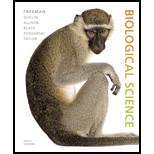
Concept explainers
Anton van Leeuwenhoek made an important contribution to the development of the cell theory. How?
a. He articulated that all organisms are made of cells.
b. He articulated that all cells come from preexisting cells.
c. He invented the first microscope and saw the first cell.
d. He invented more powerful microscopes and was the first to describe the diversity of cells.
Introduction:
The fundamental theory underlying the structural unit of life is known as cell theory. The cell theory is able to explain the structural unit, which is common in all the living organisms. The microscope development led to decoding the mystery about the fundamental unit and it confirmed that all the organisms are made up of cells. Anton van Leeuwenhoek was the first scientist to observe and describe the diversity of cells, such as blood cells, microscopic nematodes, and sperm cells.
Answer to Problem 1TYK
Correct answer:
Anton van Leeuwenhoek invented more powerful microscope and was the first to describe the diversity of cells. The efficient use of advanced magnification techniques, Anton van Leeuwenhoek observed the different type of cells.
Explanation of Solution
Explanation/Justification for the correct answer:
Option (d) is given as invention of the powerful microscope helped in describing the diversity of the cells. Anton van Leeuwenhoek was the first scientist who observes and describes the diversity of cells, such as blood cells, microscopic nematodes, and sperm cells. The magnifying power of microscopes was modified which resulted in the development of more powerful microscopes. Anton van Leeuwenhoek modified the magnifying power of microscopes, resulting in the invention of more powerful microscopes with magnification up to 300×. He was the first to observe the single-celled organisms and called them “animalcules”. Hence, Option (d) is correct.
Explanation for incorrect answers:
Option (a) is given as organisms made up of cells as an articulation. The claim was not just given by this scientist, rather a collective effort of scientists revealed that cells are the basic unit of all organism. So, it is a wrong answer.
Option (b) is given as the articulation that all cells have come from preexisting cells. This hypothesis was proposed by German scientist Rudolph Virchow. So, it is a wrong answer.
Option (c) is given as he invented the first microscope and observed by first cell Anton Van Leeuwenhoek. The first cell was observed by scientist Robert Hooke. So, it is a wrong answer.
In 1839, Schleiden & Schwann formally articulated that all organisms are composed of cells. A German scientist named Rudolph Virchow proposed that all cells arise from cells already in existence. Robert Hooke invented a microscope to examine the structure of cork from an oak tree. Leeuwenhoek further develop more powerful microscopes with magnification up to 300 ×; “×” refers to magnification power. Hence, the options (a), (b) and (c) are incorrect.
Anton van Leeuwenhoek made an important contribution to the development of the cell theory by inventing more powerful microscopes and was the first to describe the diversity of cells.
Want to see more full solutions like this?
Chapter 1 Solutions
Biological Science (6th Edition)
- Write a Hypothesis regarding Cell Structure and Function?arrow_forwardWhich of these statements is not part of the cell theory? a) The cell is the basic organizational unit of life. b) All cells come from pre-existing cells. c) All cells have a nucleus. d) All living organisms are made of one or more cells.arrow_forwardWhich scientist studied how wounds heal and proposed that cells come from preexisting cellsarrow_forward
- Which statement best summarizes why the cell theory was developed over time?arrow_forwardEvery cell is descended from another cell. This idea is part of ______. a. evolution c. the cell theory b. the theory of hereditary d. cell biologyarrow_forwardMake an essay on how a cell is similar to a house and relate the concept of compartmentalization.arrow_forward
- In the create a cell experiment, is there any difference in the structure of the two cells? The two cells was plant and animalsarrow_forwardWhat if every cell type were like a species within the animal kingdom?arrow_forwardWas the term “cell” first used when looking at a plant under a microscope or an animal?arrow_forward
- Compare and contrast plant cell from animal cell.arrow_forwardAn amoeba is a unicellular animal like protist that lives in ponds and. Streams. According to the cell theory, where did this cell come from?arrow_forwardWhat characteristic of mitochondria and chloroplasts makes themdifferent from other organelles and suggests they were onceindependent organisms?a. They have a specialized function in the cell.b. They are surrounded by a membrane.c. They contain enzymes.d. They have their own DNA and ribosomes.arrow_forward
